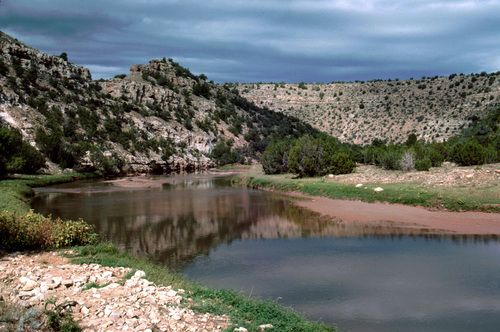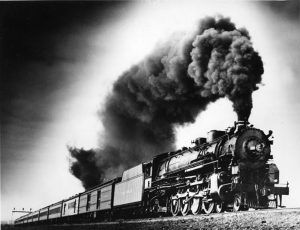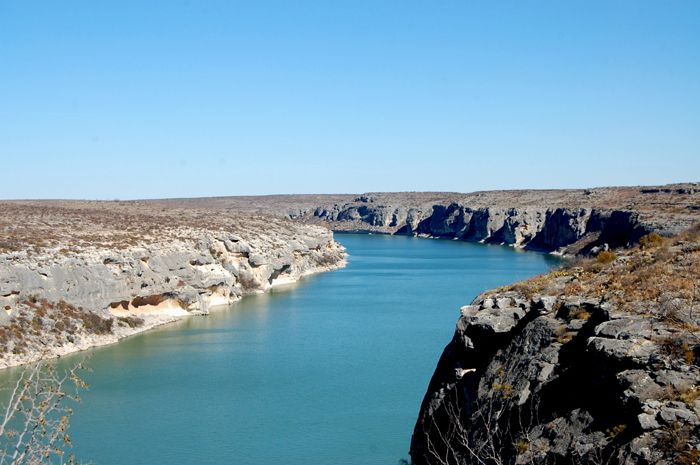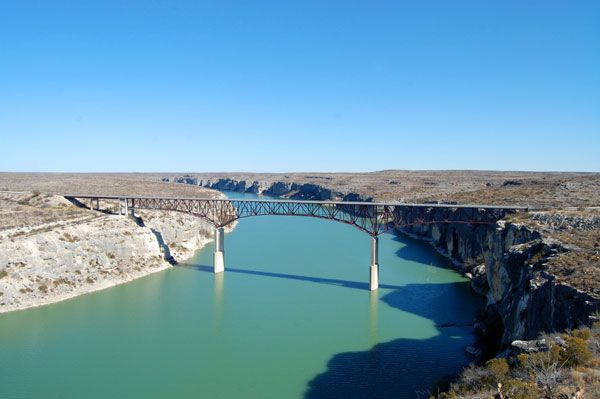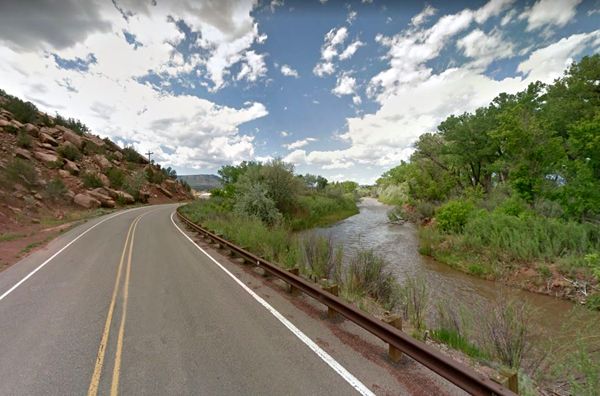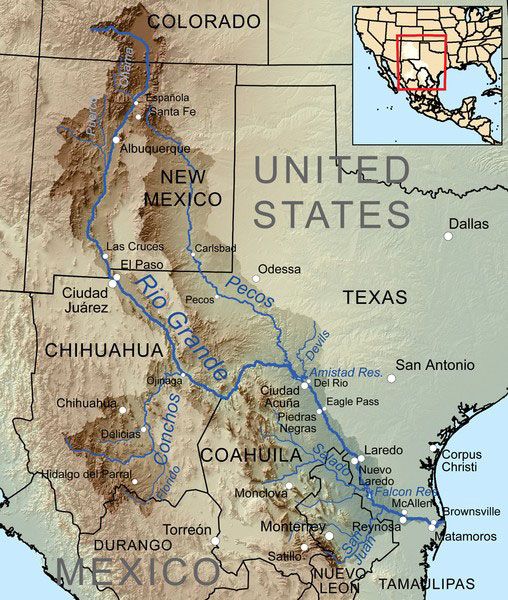
Map of the Rio Grande watershed, showing the Pecos River flowing through eastern New Mexico and West Texas, joining the Rio Grande near Del Rio, Texas. Photo courtesy Wikipedia. Click to enlarge
The Pecos River, one of the major tributaries of the Rio Grande, runs through New Mexico and Texas before it empties into the Rio Grande near Del Rio, Texas. Famous for its frontier folklore, the river flows out of the Pecos Wilderness through rugged granite canyons and waterfalls and passes small, high-mountain meadows along its 926-mile journey.
Properly pronounced “pay-cuss,” the headwaters of the Pecos River are located north of Pecos, New Mexico, at an elevation of over 12,000 feet on the western slope of the Sangre de Cristo mountain range in Mora County. The river then flows through the eastern portion of New Mexico and neighboring Texas before emptying into the Rio Grande near Del Rio. The river was named “Pecos” by the Spanish from the Keresan name of the Pecos Pueblo.
The river played a prominent role in the exploration of Texas by the Spanish. In the latter half of the 19th century, “West of the Pecos” referred to the rugged frontiers of the Wild West.
The earliest-known settlers along the river were the Pecos Pueblo Indians, who arrived about A.D. 800. The first European to cross the river was Francisco Vazquez de Coronado, who reached the area in 1541. In 1583 Antonio de Espejo called the river the Río de las Vacas, meaning “river of the cows” because of the number of buffalo in the vicinity. Spanish explorer and colonist Gaspar Castano de Sosa, who followed the Pecos northward, called it the Río Salado because of its salty taste, which caused it to be shunned by men and animals alike. The river was long known to Mexicans as the Río Puerco, meaning “dirty river.”
The earliest European settlement was founded in about 1636 at San Miguel del Vado in the upper valley of the Pecos in New Mexico. With the Anglo-American occupation of Texas, the middle and upper Pecos Valley became the chief western cattle trail to the north and the site of several famous cattle ranches.
A small church group settled at St. Gall, Texas, in 1845, and Fort Lancaster was built near the river in 1855. Except for settlement around the fort, the earliest Anglo settlement in Texas was on the river was Pecos, founded in 1881 when the Texas and Pacific Railway crossed West Texas.
Noted for its thick mineral waters and sudden floods, the Pecos River snakes through Texas on its way to the Rio Grande. Storytellers have long likened the river and the arid land along it to hell, death, and violence. A natural border for several counties, the Pecos is where the mythic Wild West begins, the land that produced the legendary Judge Roy Bean and the fabled Pecos Bill. Other scattered, disconnected bits and pieces of folklore are strewn up and down the river, including it becoming a haven for outlaws following the Civil War. This became so much so that the word became a verb in folk speech: to “Pecos” someone was to kill him and roll the body down into the river.
Historian, J. Evetts Haley, and folklorist, J. Frank Dobie, who called it “a strange river” and a “barricade,” are among many who have immortalized the Pecos River in writing. Zane Grey wrote, “Rising clear and cold in the mountains of northern New Mexico, its pure waters cut through rough country that changed its flood to turbid red.”
More tales of lost mines and buried treasure abound along the length of the waterway, especially in the area around Castle Gap, which includes stories of outlaw gold, Mexican gold, hidden money from Butterfield Stagecoach robberies, and riches from Maximilian’s short-lived “Empire of Mexico,” just to name a few.
Another local legend tells of cowboys riding the cattle trail through Castle Gap. Several ranches organized the cattle drive, and during the trek, two drovers claimed to own a big white longhorn cow. Like other disputes of the Old West days, it erupted into a gunfight, and one of the drovers was killed. Those cowboys from the opposing ranch were so upset at the shooting that they wrote the word “MURDER” on the cow’s side with a running iron. Afterward, neither side would take her, and she was released into the wilderness. Sightings of the longhorn were reported for many years, but legend has it that even other cattle wouldn’t tolerate her presence. These and many other tales added to the mystique of the Pecos River.
“Just two things that cowboys were afraid of — the Pecos River and rattlesnakes.”
— Patrick Dearen, A Cowboy of the Pecos
High Canyon walls dominate the last 60 miles of the Pecos River before it enters the Rio Grande near Del Rio. The Galveston, Harrisburg, & San Antonio Railroad built the first high bridge across the river in 1891. The first highway bridge to span the river was built about one mile downriver from the present bridge in 1928. Just 50 feet above the water, the 1928 bridge was destroyed by floodwaters in 1954, and two temporary low-water bridges were built in 1954 and 1955. These were also later destroyed by floodwaters. A new 1,310 feet long bridge was completed here in 1957. At 273 feet above the river, it is the highest highway bridge in Texas.
Near here, a Medal of Honor Fight took place in 1875. In the 1870s, the U.S. Army relied on the Black Seminole Scouts in campaigns against raiding tribes along the Mexican border. In April 1875, Lieutenant John L. Bullis and three scouts — Sergeant John Ward, Private Pompey Factor, and Trumpeter Isaac Payne, left Fort Clark to scout for raiders in the area. After four days, they found a fresh trail, and on April 25th, within a mile of the present bridge, they engaged a party of about 30 Comanche Indians with dozens of horses. Outgunned and outnumbered, the scouts withdrew, but Bullis’ horse bolted, stranding him. Factor and Payne provided cover fire, and Ward rescued his lieutenant. The three Seminole Scouts later received medals of honor for their bravery.
This wild and scenic river corridor has recently been a popular recreation setting for many decades. Its popularity continues to increase because it provides a cool, forested environment and waterway within the arid southwest, as well as beautiful scenery and high-quality fishing. Some popular recreation activities include hiking, camping, backpacking, hunting, and fishing.
© Kathy Alexander/Legends of America, updated April 2023.
Also See:
Pecos National Historic Park, New Mexico
Sources:
Handbook of Texas
National Wild & Scenic Rivers
Val Verde County Historical Commission
Wikipedia

